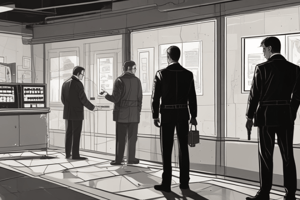Podcast
Questions and Answers
Which of the following is NOT one of the general elements involved in Crime Scene Investigation (CSI)?
Which of the following is NOT one of the general elements involved in Crime Scene Investigation (CSI)?
- Destruction (correct)
- Documenting
- Preservation
- Searching
The Principle of Exchange states that when two things come in contact, they leave traces.
The Principle of Exchange states that when two things come in contact, they leave traces.
True (A)
Who is known as the 'Father of Forensic Toxicology'?
Who is known as the 'Father of Forensic Toxicology'?
Mathieu Orfila
What did Francis Galton contribute to forensic science?
What did Francis Galton contribute to forensic science?
What does the Law of Individuality state?
What does the Law of Individuality state?
The scene of occurrence is the site where the crime has taken place.
The scene of occurrence is the site where the crime has taken place.
Which of the following is NOT a problem to be established from the examination of the scene of occurrence?
Which of the following is NOT a problem to be established from the examination of the scene of occurrence?
What is 'modus operandi'?
What is 'modus operandi'?
The ________ of Bloodstain Identification was Leone Lattes.
The ________ of Bloodstain Identification was Leone Lattes.
Match the following contributors to their fields:
Match the following contributors to their fields:
Flashcards
Crime Scene Investigation (CSI)
Crime Scene Investigation (CSI)
A process that includes searching, examining, collecting, preserving, and documenting evidence at a crime scene.
Law of Individuality
Law of Individuality
Every piece of evidence at a crime scene has unique characteristics.
Principle of Exchange
Principle of Exchange
When two objects come into contact, they exchange trace evidence.
Scene of Occurrence
Scene of Occurrence
Signup and view all the flashcards
Corpus Delicti
Corpus Delicti
Signup and view all the flashcards
Modus Operandi (MO)
Modus Operandi (MO)
Signup and view all the flashcards
Chain of Custody
Chain of Custody
Signup and view all the flashcards
Forensic Toxicology
Forensic Toxicology
Signup and view all the flashcards
Fingerprint Analysis
Fingerprint Analysis
Signup and view all the flashcards
Crime Scene Photography
Crime Scene Photography
Signup and view all the flashcards
Study Notes
Crime Scene Investigation
- CSI is a combination of various elements, including searching, preliminary examination, collection, preservation, and documentation.
Principle and Law of Forensic Science
- Law of Individuality: Every item involved in a crime has unique characteristics.
- Principle of Exchange: When objects come into contact, they exchange traces.
- Law of Progressive Change: Things change over time.
- Law of Comparison: Only similar items can be compared.
- Law of Analysis: The quality of analysis depends on the sample.
- Law of Probability: Identification is based on probabilities.
- Law of Circumstantial Fact: Facts are reliable.
History Of Forensic Investigation
- Mathieu Orfila (1787-1853): Father of forensic toxicology.
- Francis Galton (1822-1911): Distinguished fingerprints and their patterns.
- Alphonse Bertillon (1853-1914): Father of criminal detection; created a system of physical measurements for identification.
- Albert S. Osborn (1858-1946): Father of questioned documents; established the credibility of documents as evidence.
Securing and Searching the Crime Scene
- The scene of occurrence is the site where a crime or incident happened.
- The scene is the meeting place of involved parties.
- The scene provides information about the criminal, victim and their interactions.
- Evaluation includes taking photographs and 3D scans, sketching, searching, recording, and using modern aids.
- Protection of the scene is paramount to maintain integrity.
- Investigators should preserve the crime scene and avoid moving or altering evidence.
- They should exclude unauthorized people, maintain order and ensure witnesses do not interact.
Recording the Crime Scene
- Common methods for recording are note-taking, sketching, and photography.
- Modern methods incorporate videography and 3D scanning for better representation.
Searching the crime scene
- Zonal method (inward or outward), Strip method, Cross-hatch method, Spiral Method.
- Proper equipment's is necessary, such as DSLR, Videography, and 3D cameras, body cameras, and drones.
- Details of the location are necessary to maintain proper integrity of the examination and recording.
Packaging
- Evidence should be packaged in new, sterilized containers to prevent contamination.
- Containers should be sealed and marked with investigator's signature.
- Proper techniques must be used to prevent loss, tempering, or damage.
Types of Bloodstains
- Passive bloodstains are from gravity.
- Transfer bloodstains are from contact.
- Projected bloodstains are due to force greater than gravity.
- Drip stains
- Splash patterns
- Flow patterns
- Pools
- Serum stains
Death Investigation
-
Autopsy: A surgical procedure to examine the cause of death.
- Medico-legal autopsy: For suspicious or unnatural deaths.
- Pathological autopsy: For natural deaths.
- Virtual autopsy: A technology to provide a bloodless examination.
-
Objectives: To determine the cause, manner, and mode of death, detect injuries, identify possible weapons of offence, time of death and the position of the body.
-
Postmortem changes include Livor mortis, rigor mortis and decomposition.
- Livor mortis: Discoloration due to blood settling in the body.
- Rigor mortis: Stiffening of muscles.
- Decomposition: Breakdown of tissues.
-
Algor mortis: Decrease in body temperature post-death.
-
Mummification: Dehydration of tissues.
Additional notes
- Fingerprints: Method of collection and packaging.
- Firearms: Method of protection, collection, and packaging.
Studying That Suits You
Use AI to generate personalized quizzes and flashcards to suit your learning preferences.




